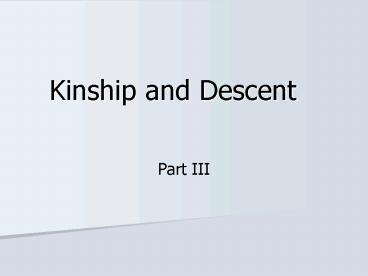Kinship and Descent - PowerPoint PPT Presentation
1 / 18
Title:
Kinship and Descent
Description:
Kinship and Descent Part III Kindred A small circle of paternal and maternal relatives. A kindred is never the same for any two persons except siblings. – PowerPoint PPT presentation
Number of Views:207
Avg rating:3.0/5.0
Title: Kinship and Descent
1
Kinship and Descent
- Part III
2
Kindred
- A small circle of paternal and maternal
relatives. - A kindred is never the same for any two persons
except siblings. - EGO is the central person from whom the degree of
each relationship is traced.
3
The Kindred
- Kindred an individuals close blood relatives on
the maternal and paternal sides of his pr her
family. - Kindreds are not clearly bounded and lack the
distinctiveness of the lineage. - Since the kindred is laterally rather than
lineally organized (that is, EGO, or the central
personal from whom the degree of each
relationship is traced, is the center of the
group) it is not a true descent group.
4
Kindred
- Unlike a decent group, the kindred is not
self-perpetuating (it ceased with EGOs death). - It has no constant leader, nor can it easily
hold, administer, or pass on property. - Because of its vagueness, temporary nature, and
changing affiliation, the kindred cannot function
as a group except in relations to EGO. - It can, however, be turned to for aid.
- Kindreds also can regulate marriage through
exogamy
5
Question
- When the membership of a descent group grows too
large, ___________ may occur, creating two new,
smaller lineages. - fusion
- lineal decrease
- fission
- exogamy
6
Answer C
- When the membership of a descent group grows too
large, fission may occur, creating two new,
smaller lineages.
7
Question
- Membership in a __________ is determined not by
descent from a common ancestor (as in descent
groups) but by the fact that they share a living
relative (ego). - clan
- lineage
- phratry
- kindred
8
Answer D
- Membership in a kindred is determined not by
descent from a common ancestor (as in descent
groups) but by the fact that they share a living
relative (ego).
9
Clans and Kinship
- Lineages arise from extended family organization.
- Lineages will develop, and these may with time
give rise to clans and ultimately moieties. - Another way that clans may arise is as fictive
kin groups to politically integrate otherwise
autonomous ethnic groups. - Over time, economic and social changes may weaken
descent groups, or they may persist, due to
integrative functions.
10
Kinship Terminologies
- Kinship terminology is related to the kinds of
kinship groups that exist in a society. - All terminologies both classify and separate
different kinds of individuals, emphasizing sex,
generational differences, or genealogical
differences. - Regardless of the factors emphasized, all kinship
terminologies accomplish two important tasks. - First, they classify similar kinds of individuals
into single specific categories - Second, they separate different kinds of
individuals into distinct categories.
11
Eskimo System
- Kinship reckoning in which the nuclear family is
emphasized by specifically identifying the
mother, father, brother, and sister, while
lumping together all other relatives into broad
categories such as uncle, aunt, and cousins. - comparatively rare among all the worlds systems
- is used by Euramericans, as well as by a number
of food-foraging peoples - Unlike other terminologies it provides separate
and distinct terms for the nuclear family members - is referred to as the lineal system
12
Eskimo System
13
Hawaiian System
- Kinship reckoning in which all relatives of the
same sex and generation are referred to by the
same term. - the least complex system, in that it uses the
fewest terms - reflects the absence of strong unilineal descent,
and members on both the fathers and mothers
side are viewed as more or less equal - is referred to as the generational system
14
Hawaiian System
15
Hawaiian System
- Polynesian societies throughout the Pacific Ocean
are traditionally structured conforming to the
Hawaiian system of kinship terminology.
16
Iroquois System
- Kinship reckoning in which a father and fathers
brother are referred to by a single term, as are
a mother and mothers sister, but a fathers
sister and mothers brother are given separate
terms. - parallel cousins are classified with brothers and
sisters - cross cousins are classified separately, but not
equated with relatives of some other generation - very widespread and is usually found with
unilineal descent groups
17
Iroquois System
18
New Reproductive Technologies
- Kin terms are challenged in the age of new
reproductive technologies - Beyond transforming our sense of being human,
they force us to redefine established ideas about
the status of relatives, challenging us to
rethink what being related to others is about,
and specifically, what our rights and obligations
are toward such unfamiliar categories of kin.































